The purpose of this activity is to support students in finding the structure of one shape within a growing pattern. Relating parts of the single shape to the shape number offers possibilities for creating function rules.
- Square tiles or squared paper
- PowerPoint (in paper form or displayed on a shared screen)
- Show the students slide 1 of the PowerPoint.
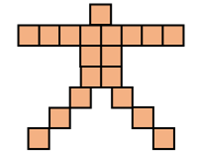
Describe this shape.
Count the squares in groups.
Can you use symmetry?
- This shape is part of a repeating pattern.
Here is a schematic drawing of it.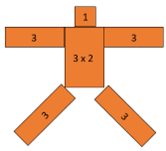
- Support students to develop relevant schematic drawings.
What shapes come before and after this shape?
Use schematic drawings. This means we draw the general shape of each part of the shape, without drawing every square.
Let the students use schematic diagrams to show the previous and later shapes in the pattern.
- Provide time for students to share their drawings with a range of their peers. Their drawings should look like the ones shown below (draw these for students to see).
Do your drawings look similar to the ones I have here? What are the differences?
Students may have other legitimate ways to extend the pattern. Make sure they understand why the body of each shape is represented as n x 2, if n is the shape number. The body is an array with a fixed width of two squares.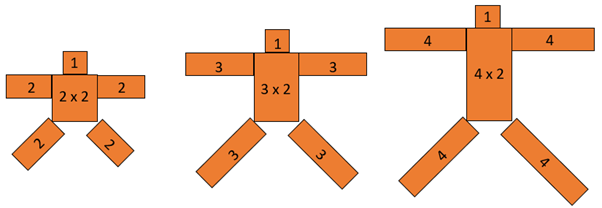
- Use what you know to predict the number of squares in shape ten.
Be prepared to justify your prediction.
Let the students choose their own strategy. Students might work in pairs, work independently, or work with the teacher. Look for the following:
- Making a table of values. This tends to be used recursively (adding to get the next term) once the students recognise that six squares are added to each shape to get the next.
Why does the pattern grow by six squares each time?
The process is quite laborious, even more so if the target shape number is much larger.
Is there an easier way to find the number of squares in shape ten?
| Shape number | 1 | 2 | 3 | 4 | 5 | 6 | 7 | 8 | 9 | 10 |
| Number of squares | 7 | 13 | 19 | 25 | 31 | 37 | 43 | 49 | 55 | 61 |
| Change in number of squares | +6 | +6 | +6 | +6 | +6 | +6 | +6 | +6 | +6 |
- Schematic drawing, combined with writing an expression. This strategy makes use of the structure found in the Shape Three and leads directly to the function rule: 4 x 10 + 10 x 2 + 1
Look for students to notice that there are six lines of ten squares in the whole shape.
Can you write the expression more simply? (6 x 10 + 1 since 10 x 2 = 2 x 10)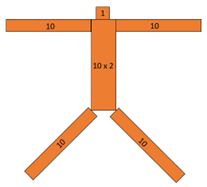
Gather the students to share strategies.
Which strategy is the most efficient? Explain why.
Can you create a general rule?
If I give you any shape number, you can work out the number of squares?
Students should call on their recognition of structure in the diagrams, and table of values.
Can you draw a diagram for Shape n?
Write an expression for the number of squares in Shape n.
Students might need to be told of the convention that 6n represents “n multiplied by six.”
6n+1.
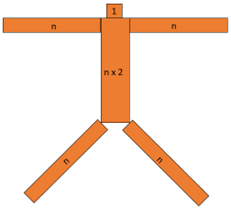
- Ask students to use the shapes found on slides 4 and 5 of the PowerPoint to develop similar growth patterns. They should attempt to find a general rule for each pattern.
Next steps
- Continue to support students to transfer their understanding of creating word rules to using algebraic notation. Work on expressing word statements algebraically, such as:
| Words | Symbols |
| The number two less than n. | n-2 |
| The number three more than n. | n+3 |
| The number that is n multiplied by five. | 5n |
| The number that is n divided by three. | n/3 |
| N multiplied by itself | n2 |
- Provide further practice opportunities by removing either the words or symbols in a table like the one shown above, before asking students to complete the missing entries.